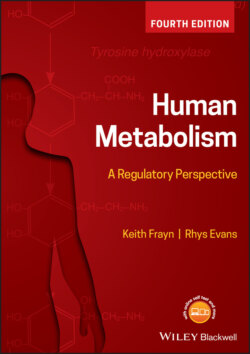Читать книгу Human Metabolism - Keith N. Frayn - Страница 27
1.3.1.2 Energy substrates
ОглавлениеBy utilising three, chemically diverse, fuel groups, overall metabolic flexibility and hence efficiency are achieved. Energy derived from these compounds is all based on a reduced carbon atom i.e. the C–H bond. Hence, the more C–H bonds, the more reduced the molecule and the more energy it contains, whereas oxidised or partially oxidised carbon (C–O) lacks biochemically usable energy (see Section 1.2.1.3). However, generally speaking, the more reduced the substrate, the less water soluble it is likely to be. This may be an advantage or a disadvantage, depending on the role of the substrate.
Carbohydrates are partially oxidised and hence do not contain as much energy (17 kJ g−1) as the highly reduced (–CH rich) lipids. However, carbohydrates are soluble, hence quickly mobilised and utilised, and are relatively non-toxic. Furthermore, some energy can be derived from them anaerobically during hypoxia or ischaemia. However, their water solubility means that in storage form (glycogen) they retain significant water of hydration (about three times their own weight), lowering their energy density and efficiency as energy stores (see Figure 1.10): only very limited amounts are stored (hepatic glycogen ∼ 100g only), but since they can be converted to many other substances, including lipids and intermediates of the tricarboxylic acid (TCA) cycle (also known as the Krebs cycle – see Section 1.3.1.4), they are therefore metabolically ‘flexible’ – carbohydrates are able to supply intermediary metabolites to maintain pathway integrity (anaplerosis, again from the Greek ανα (ana), up, πληρω (plero), to fill) in contrast to lipids, oxidation of which leads to depletion of intermediary metabolites (cataplerosis): hence some carbohydrate is always required for metabolism to proceed efficiently, as captured in the old aphorism ‘fat burns in the fire of carbohydrate.’ This is discussed later (Box 5.3).
Fats are the most energy-dense metabolic fuels (∼37 kJ g−1): lipids are highly reduced (energetic), water-insoluble, and very energy-dense, hence their function as the principal energy store for free-living animals, and are major energy providers to most (oxidative) tissues. However, their water-insolubility makes lipids problematic and slow to mobilise, and unlike carbohydrates they cannot yield energy anaerobically – they must be oxidised, therefore cannot be used by red blood cells (erythrocytes) and renal medulla. Because they are more reduced, relatively more oxygen is required to extract energy from lipids (2.8 ATP/O2) compared to carbohydrates (3.7 ATP/O2) and this may be critical in high work-load oxygen-challenged tissues such as myocardium (and exercising skeletal muscle). The storage form of lipids for energy provision is triacylglycerol, which comprises three fatty acids esterified to a glycerol backbone. Being highly hydrophobic and reduced, triacylglycerols are very energy dense and a highly efficient energy store. However, triacylglycerols are relatively slow to mobilise, must be oxidised to yield energy and cannot provide energy anaerobically, and the NEFAs from which they are assembled are amphipathic (detergent- like) and hence potentially toxic in high concentrations, disrupting structural lipids especially in the central nervous system: they cannot cross the blood-brain barrier so also cannot be used by the central nervous system (more detail in Section 5.6). Furthermore, fatty acids cannot be converted into carbohydrates or proteins, limiting their metabolic flexibility.
Proteins (polymers of amino acids) have similar energy content to carbohydrates (∼17 kJ g−1), but each protein has a specific biological function and they are not used as dedicated energy stores. Amino acids (proteins) have similar energy yields to carbohydrates i.e. they are partially oxidised to about the same extent as carbohydrates, and overall have comparable solubility; since most can be converted into glucose (‘glucogenic’), they have similar metabolic flexibility to carbohydrates. In catabolic states of carbohydrate depletion (e.g. starvation), however, proteins are broken down to their constituent amino acids for conversion into glucose to supply glucose-dependent tissues such as brain and erythrocytes for energy, and also to provide general tissue anaplerosis – hence proteins constitute a ‘virtual’ carbohydrate store in catabolic states of carbohydrate exhaustion.
